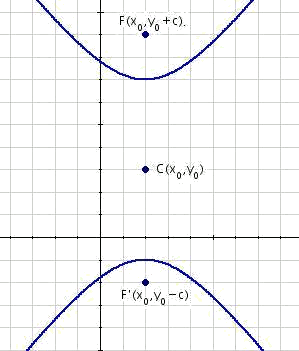
Next the vertical hyperbolas are analyzed with center in the generic point
Applying now the general definition we obtain
The root is added, and we square it:
On having simplified and dividing by four:
On having cleared the root and having squared again:
Then divide by
On having applied the definition
Next, a practical example to observe the steps performed to solve the equation for the vertical hyperbola.
Example
Find the equation of the hyperbola which foci are at the points
Identifying in
Applying the formula for the eccentricity
Applying now
On developing the equation as much for the vertical as for the horizontal hyperbola, it is possible to express the equation in general, as:
Example
To convert the equation of the previous exercise into the form
From
